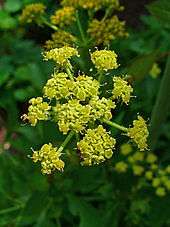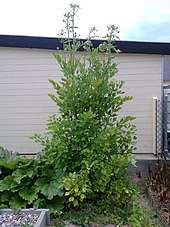Lovage
Lovage (/ˈlʌvɪdʒ/), Levisticum officinale, is a tall perennial plant, the sole species in the genus Levisticum in the family Apiaceae, subfamily Apioideae.[1][2] It has been long cultivated in Europe, the leaves being used as a herb, the roots as a vegetable, and the seeds as a spice, especially in southern European cuisine.
| Lovage | |
|---|---|
| Scientific classification | |
| Kingdom: | Plantae |
| Clade: | Tracheophytes |
| Clade: | Angiosperms |
| Clade: | Eudicots |
| Clade: | Asterids |
| Order: | Apiales |
| Family: | Apiaceae |
| Subfamily: | Apioideae |
| Genus: | Levisticum Hill |
| Species: | L. officinale |
| Binomial name | |
| Levisticum officinale | |
Description

Lovage is an erect, herbaceous, perennial plant growing to 1.8–2.5 m (5.9–8.2 ft) tall, with a basal rosette of leaves and stems with further leaves, the flowers being produced in umbels at the top of the stems. The stems and leaves are shiny glabrous green to yellow-green and smell somewhat similar to celery when crushed. The larger basal leaves are up to 70 cm (28 in) long, tripinnate, with broad triangular to rhomboidal, acutely pointed leaflets with a few marginal teeth; the stem leaves are smaller, and less divided with few leaflets. The flowers are yellow to greenish-yellow, 2–3 mm (0.079–0.118 in) diameter, produced in globose umbels up to 10–15 cm (3.9–5.9 in) diameter; flowering is in late spring. The fruit is a dry two-parted schizocarp 4–7 mm (0.16–0.28 in) long, mature in autumn.[3]
Distribution
The exact native range is disputed; some sources cite it as native to much of Europe and southwestern Asia,[4] others from only the eastern Mediterranean region in southeastern Europe and southwestern Asia,[5] and yet others only to southwestern Asia in Iran and Afghanistan, citing European populations as naturalised.[6][7] It has been long cultivated in Europe, the leaves being used as an herb, the roots as a vegetable, and the seeds as a spice, especially in southern European cuisine.[5]
Properties and uses
The leaves can be used in salads, or to make soup or season broths, and the roots can be eaten as a vegetable or grated for use in salads. Its flavor and smell can be described as a mix of celery and parsley, but with a higher intensity of both of those flavors. The seeds can be used as a spice, similar to fennel seeds.[5]
- In the Netherlands, lovage leaves are traditionally cooked with white asparagus and salt; and served with boiled eggs.
- In Romania, the leaves are the preferred seasoning for the various local broths, equally as much as parsley or dill.[8]
- In the UK, an alcoholic lovage cordial is traditionally added to brandy as a winter drink and is or was popular in Cornwall where it was originally added to slightly spoiled smuggled brandy to hide the taste of salt.[9]
The roots, which contain a heavy, volatile oil, are used as a mild aquaretic.[10] Lovage root contains furanocoumarins which can lead to photosensitivity.[11] In Romania it is also used dried and with seeds to conserve and to add flavour to pickled cabbage and cucumbers.[12]
Etymology

The name "lovage" is from "love-ache", ache being a medieval name for parsley; this is a folk-etymological corruption of the older French name levesche, from late Latin levisticum, in turn thought to be a corruption of the earlier Latin ligusticum, "of Liguria" (northwest Italy), where the herb was grown extensively.[13] In modern botanical usage, both Latin forms are now used for different (but closely related) genera, with Levisticum for (culinary) lovage, and Ligusticum for Scots lovage, a similar species from northern Europe, and for related species.[13]
Other languages
References
- Pimenov, M. G. & Leonov, M. V. (1993). The Genera of the Umbelliferae. Royal Botanic Gardens, Kew. ISBN 0-947643-58-3.
- Downie, S. R., Plunkett, G. M., Watson, M. F., Spalik, K., Katz-Downie, D. S., Valiejo-Roman, C. M., Terentieva, E. I., Troitsky, A. V., Lee, B.-Y., Lahham, J., and El-Oqlah, A. (2001). "Tribes and clades within Apiaceae subfamily Apioideae: the contribution of molecular data". Edinburgh Journal of Botany. 58 (2): 301–330. doi:10.1017/s0960428601000658.CS1 maint: multiple names: authors list (link)
- Interactive Flora of NW Europe: Levisticum officinale (Lovage)
- Den virtuella floran: Levisticum officinale (in Swedish), with map
- Huxley, A., ed. (1992). New RHS Dictionary of Gardening. ISBN 0-333-47494-5.
- Blamey, M. & Grey-Wilson, C. (1989). Illustrated Flora of Britain and Northern Europe. ISBN 0-340-40170-2.
- "Levisticum officinale". Germplasm Resources Information Network (GRIN). Agricultural Research Service (ARS), United States Department of Agriculture (USDA). Retrieved 11 December 2017.
- "În ce fel de ciorbe este indicat să folosim leuşteanul. Cât de multe frunze puternic aromate putem pune". adevarul.ro. 23 February 2017. Retrieved 2019-03-17.
- Information on Lovage Cordial Archived 2011-10-06 at the Wayback Machine
- "Community herbal monograph on Levisticum officinale Koch, radix" (pdf). European Medicines Agency. 2012-03-27. Retrieved 2015-07-28.
- Ashwood-Smith MJ, Ceska O, Yeoman A, Kenny PG (May 1993). "Photosensitivity from harvesting lovage (Levisticum officinale)". Contact Dermatitis. 26 (5): 356–7. doi:10.1111/j.1600-0536.1992.tb00138.x. PMID 1395606.
- "Cum faci cele mai gustoase murături". Adevarul newspaper. Retrieved 17 March 2019.
- "lovage". Oxford English Dictionary (3rd ed.). Oxford University Press. September 2005. (Subscription or UK public library membership required.)
- Udo Pini. Das Gourmet Handbuch. ISBN 978-3-8480-0584-0.
- Source: http://www.dict.cc/?s=Liebst%C3%B6ckel, see also German Wikipedia article
- Udo Pini. Das Gourmet Handbuch. ISBN 978-3-8480-0584-0.
External links
